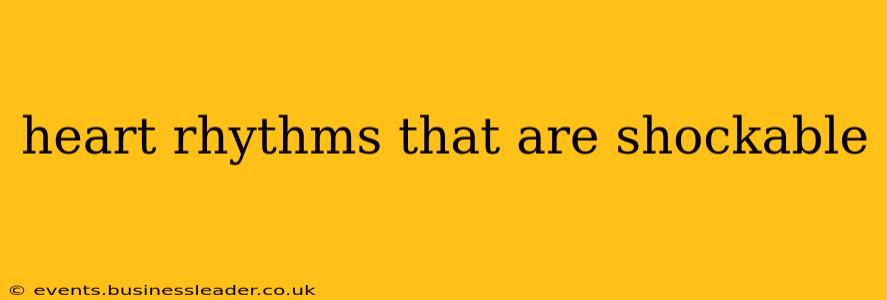Sudden cardiac arrest (SCA) is a life-threatening emergency where the heart suddenly stops beating effectively. While many heart rhythm disturbances can cause SCA, only certain ones are responsive to defibrillation, a procedure that uses an electric shock to try and restore a normal heartbeat. This article will delve into the shockable heart rhythms, explaining what they are, why they're shockable, and the crucial role of early defibrillation in saving lives.
What is Defibrillation?
Defibrillation is a crucial life-saving technique used to treat life-threatening heart rhythms. It involves delivering a precisely timed electrical shock to the heart to interrupt chaotic electrical activity and allow the heart's natural pacemaker to resume its normal rhythm. This shock isn't used to start the heart; it's designed to reset it from a dangerous rhythm that's preventing effective blood circulation.
Shockable Heart Rhythms: Ventricular Fibrillation (VF) and Pulseless Ventricular Tachycardia (pVT)
The two primary shockable rhythms are:
Ventricular Fibrillation (VF)
VF is a chaotic, disorganized electrical activity in the ventricles (the lower chambers of the heart). The heart quivers instead of pumping blood effectively, leading to cardiac arrest. On an electrocardiogram (ECG), VF appears as a wavy baseline without identifiable P waves, QRS complexes, or T waves—a chaotic jumble of electrical activity. This rhythm is completely unresponsive, meaning the patient will be unconscious and pulseless. VF is always shockable.
Pulseless Ventricular Tachycardia (pVT)
pVT is a rapid heart rhythm originating in the ventricles. Although the heart is beating rapidly, it's not pumping blood effectively because the ventricles are contracting too fast and erratically. The patient will be unconscious and pulseless. pVT is also always considered shockable.
Why Are VF and pVT Shockable?
Both VF and pVT represent life-threatening situations where the heart is unable to pump blood effectively. The electrical shock from a defibrillator aims to depolarize (reset) the heart's muscle cells simultaneously, allowing the heart's natural electrical conduction system to potentially resume a normal rhythm. This sudden reset is vital in interrupting the lethal cycle of these arrhythmias.
What Heart Rhythms Are NOT Shockable?
It's crucial to understand that not all abnormal heart rhythms require defibrillation. Administering a shock to a non-shockable rhythm can be harmful. Examples of non-shockable rhythms include:
- Asystole (flatline): Complete absence of electrical activity in the heart. CPR and medications are the primary interventions.
- Pulseless Electrical Activity (PEA): Organized electrical activity is present on the ECG, but the heart isn't pumping blood effectively. CPR and addressing underlying causes are the focus.
- Organized rhythms with a pulse: Rhythms such as sinus tachycardia or supraventricular tachycardia (SVT) might be rapid but are typically pumping blood, even if inefficiently. Treatment would focus on medication or other interventions to slow the heart rate.
H2: What are the signs of a shockable heart rhythm?
The signs of a shockable heart rhythm (VF and pVT) are consistent with cardiac arrest:
- Unconsciousness: The person is unresponsive and not awake.
- Absence of breathing or only gasping breaths: Normal breathing is absent.
- No pulse: You cannot feel a pulse in the neck or wrist.
It's important to remember that only trained medical professionals can definitively diagnose a shockable rhythm using an ECG. Laypersons relying on defibrillators (like those found in public places) should follow the device prompts; the device itself will analyze the rhythm and advise whether a shock is needed.
H2: How is defibrillation performed?
Defibrillation involves attaching defibrillator pads to the chest and delivering a controlled electrical shock. The procedure is guided by the defibrillator machine and should only be performed by trained medical personnel or using an automated external defibrillator (AED) according to the device's instructions. Immediate CPR should be initiated before and after the shock, if necessary.
H2: What are the risks associated with defibrillation?
While defibrillation is a life-saving procedure, there are potential risks, though generally low when performed correctly:
- Burns: Skin burns can occur at the pad placement sites.
- Rib fractures: The forceful contractions following the shock can occasionally lead to rib fractures.
- Arrhythmias: Although rare, defibrillation can occasionally trigger other arrhythmias.
These risks are significantly outweighed by the potential for saving a life.
Conclusion:
Understanding shockable heart rhythms is crucial for anyone involved in emergency medical care. Early defibrillation is a critical link in the chain of survival for victims of sudden cardiac arrest. The prompt recognition of VF and pVT, followed by immediate defibrillation, can significantly improve the chances of survival. Remember, early CPR and access to a defibrillator are key components in saving lives.
